Android application often needs settings that allow users to modify preferences in app. Android provides a powerful framework to manage user preferences. It allows us to define the way we want preferrences and it automatically generates UI for that. All we need to do is to simply use it in our app.
Let us see in this tutorial how to integrate Android’s Preference framework (PreferenceActivity) in any android app. Create a Hello World Android project in Eclipse. Go to New > Project > Android Project.
Give the project name as Android_Preferences_example and select Android Runtime 2.1 or sdk 7. This will generate a basic skeleton of project. But once we add all required source code the project structure would looks like following:
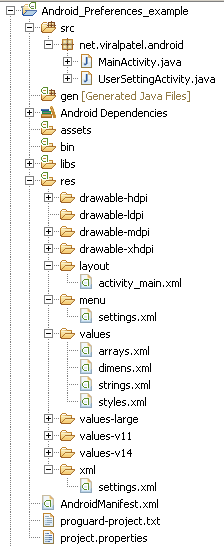
Once you are done with above steps, you will have a basic hello world Android App. The Preference framework comes with an activity class android.preference.PreferenceActivity which needs to be overridden with our own class. Create a class UserSettingsActivity under package net.viralpatel.android where all activities are stored for this app. Copy following code into it.
File: UserSettingActivity.java
package net.viralpatel.android;
import android.os.Bundle;
import android.preference.PreferenceActivity;
public class UserSettingActivity extends PreferenceActivity {
@Override
public void onCreate(Bundle savedInstanceState) {
super.onCreate(savedInstanceState);
addPreferencesFromResource(R.xml.settings);
}
}
Code language: Java (java)In above class, we are adding preferences to the app using addPreferencesFromResource method. We specified an xml file id with this method. Create a new XML file under /xml directory class settings.xml and copy following code into it.
File: xml/settings.xml
<?xml version="1.0" encoding="utf-8"?>
<PreferenceScreen xmlns:android="http://schemas.android.com/apk/res/android" >
<PreferenceCategory android:title="@string/pref_user_profile" >
<EditTextPreference
android:title="@string/pref_user_name"
android:summary="@string/pref_user_name_summary"
android:key="prefUsername"/>
</PreferenceCategory>
<PreferenceCategory android:title="@string/pref_update_setting" >
<CheckBoxPreference
android:defaultValue="false"
android:key="prefSendReport"
android:summary="@string/pref_send_report_summary"
android:title="@string/pref_send_report" >
</CheckBoxPreference>
<ListPreference
android:key="prefSyncFrequency"
android:entries="@array/syncFrequency"
android:summary="@string/pref_sync_frequency_summary"
android:entryValues="@array/syncFrequencyValues"
android:title="@string/pref_sync_frequency" />
</PreferenceCategory>
</PreferenceScreen>Code language: HTML, XML (xml)Note how we defined the user interface of settings page in above xml file. We created two different Preference categories, One which shows Users Profile related settings and another Update related settings. The setting page has 3 different components to specify user settings.
EditTextPreferenceis used to define an editable text property. In this example username is editable property.CheckBoxPreferenceallows you to define a boolean value in preference screen. In this example we define a property to check weather to send crash report or not.ListPreferenceas its name suggest allows user to select any one item from a given list. In this example we let user to decide what should be the frequency for data sync.
The list we defined in above Preference settings file will be declared as an array in arrays.xml. Create a file arrays.xml (if not present already in your project) in /res/values folder and copy following content into it:
File: arrays.xml
<?xml version="1.0" encoding="utf-8"?>
<resources>
<string-array name="syncFrequency">
<item name="1">Once a day</item>
<item name="7">Once a week</item>
<item name="3">Once a year</item>
<item name="0">Never (Update manually)</item>
</string-array>
<string-array name="syncFrequencyValues">
<item name="1">1</item>
<item name="7">7</item>
<item name="30">30</item>
<item name="0">0</item>
</string-array>
</resources>Code language: HTML, XML (xml)In addition to arrays.xml, we will also need some string values for our app. Below is the list of string constant that we will add in strings.xml file.
File: strings.xml
<resources>
<string name="app_name">Android_Preferences_example</string>
<string name="hello_world">Hello world!</string>
<string name="menu_settings">Settings</string>
<string name="title_activity_main">MainActivity</string>
<string name="pref_send_report">Send crash reports</string>
<string name="pref_send_report_summary">Helps to fix bugs</string>
<string name="pref_sync_frequency">Sync frequency</string>
<string name="pref_sync_frequency_summary">Set the sync frequency</string>
<string name="pref_user_name">Set username</string>
<string name="pref_user_name_summary">Set your username</string>
<string name="pref_user_profile">User Profile</string>
<string name="pref_update_setting">Update Settings</string>
</resources>
Code language: HTML, XML (xml)We have now created the basic setup for Preferences in our app. Now we need to integrate it with our actual Activity. First we need to create a menu which will be shown when User clicks menu button. This menu will have only one menuitem, Settings. On click on this item, we will display the Settings preference screen. Create a file settings.xml under /res/menu folder and copy following content into it:
File: menu/settings.xml
<menu xmlns:android="http://schemas.android.com/apk/res/android" >
<item
android:id="@+id/menu_settings"
ic_menu_preferences=""
android:orderInCategory="100"
android:showAsAction="never"
android:title="@string/menu_settings"
android:icon="@android:drawable/ic_menu_preferences"/>
</menu>
Code language: HTML, XML (xml)Create a new Activity class MainActivity under net.viralpatel.android package and copy following code into it:
File: MainActivity.java
package net.viralpatel.android;
import android.app.Activity;
import android.content.Intent;
import android.content.SharedPreferences;
import android.os.Bundle;
import android.preference.PreferenceManager;
import android.view.Menu;
import android.view.MenuItem;
import android.widget.TextView;
public class MainActivity extends Activity {
private static final int RESULT_SETTINGS = 1;
@Override
public void onCreate(Bundle savedInstanceState) {
super.onCreate(savedInstanceState);
setContentView(R.layout.activity_main);
showUserSettings();
}
@Override
public boolean onCreateOptionsMenu(Menu menu) {
getMenuInflater().inflate(R.menu.settings, menu);
return true;
}
@Override
public boolean onOptionsItemSelected(MenuItem item) {
switch (item.getItemId()) {
case R.id.menu_settings:
Intent i = new Intent(this, UserSettingActivity.class);
startActivityForResult(i, RESULT_SETTINGS);
break;
}
return true;
}
@Override
protected void onActivityResult(int requestCode, int resultCode, Intent data) {
super.onActivityResult(requestCode, resultCode, data);
switch (requestCode) {
case RESULT_SETTINGS:
showUserSettings();
break;
}
}
private void showUserSettings() {
SharedPreferences sharedPrefs = PreferenceManager
.getDefaultSharedPreferences(this);
StringBuilder builder = new StringBuilder();
builder.append("\n Username: " +
sharedPrefs.getString("prefUsername", "NULL"));
builder.append("\n Send report:" +
sharedPrefs.getBoolean("prefSendReport", false));
builder.append("\n Sync Frequency: " +
sharedPrefs.getString("prefSyncFrequency", "NULL"));
TextView settingsTextView = (TextView) findViewById(R.id.textUserSettings);
settingsTextView.setText(builder.toString());
}
}Code language: Java (java)In above MainActivity, showUserSettings method fetches the values stored in Preferences and display on screen. Note how we used Preference API for that:
SharedPreferences sharedPrefs = PreferenceManager
.getDefaultSharedPreferences(this);
sharedPrefs.getString("prefUsername", "NULL");
sharedPrefs.getBoolean("prefSendReport", false);Code language: Java (java)Finally we need layout to display our MainActivity. Below is the layout file. This will display all selected preference values from the Settings screen.
File: layout/activity_main.xml
<LinearLayout xmlns:android="http://schemas.android.com/apk/res/android"
xmlns:tools="http://schemas.android.com/tools"
android:layout_width="match_parent"
android:layout_height="match_parent" >
<TextView
android:id="@+id/textUserSettings"
android:layout_width="wrap_content"
android:layout_height="wrap_content"
android:padding="@dimen/padding_medium"
tools:context=".MainActivity" />
</LinearLayout>
Code language: HTML, XML (xml)Screen shots of Android App
And that’s all! Just execute the app in Android emulator or real device and see following output.
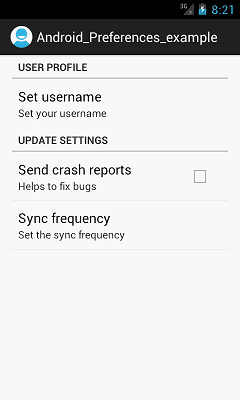
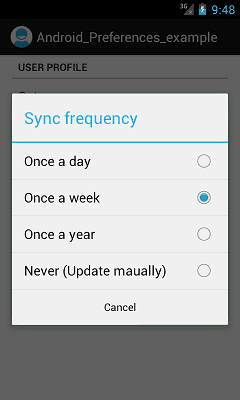
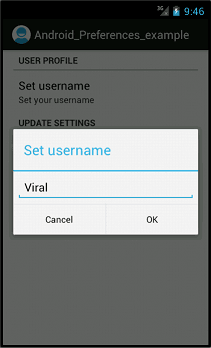
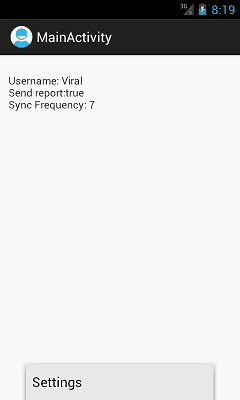
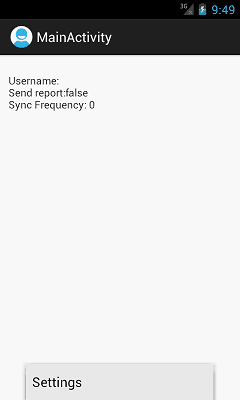
Download Source Code
Android_Preferences_example.zip (331 KB)
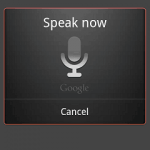

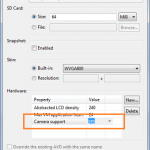
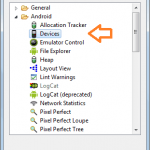
Hello Sir,
How to create graph in android application.Plz,help me….
Thanks
Bhadresh
This is a late response but, use AchartEngine to create different types of graphs in android.
Pie
Very nice and simple explanation of preference, thanks.
Just for a bit more finishing you should have register and unregister during onResume and onPause also. you can see why by tilting your screen (cntrl + F12).
Call showUserSettings(); in onResume();
i am unable to fetch integers value from list preference to main activity . i want to use those integer values in my actvity.
Just want to say thanks for such a nice tutorial. (Much better than on the Android developer website) Did have to change the MainActivity function
to
as the resource file is named settings.
Thanks a lot
You should update the example as
is depreciated
@Shubham – Unfortunately Android doesn’t have any easy way of supporting PreferenceActivity unless we change it and use PreferenceFragement. I’m planning to write a new tutorial using PreferenceFragement. Will post a link on this one :)
This post is, of course, over 3 years old and I don’t know if the site is being maintained at all. I couldn’t find an update demonstrating PreferenceFragment. I really liked the way this tutorial is presented and I was hoping you had a link to another tutorial that explains how to move from PreferenceActivity to PreferenceFragment. Thanks in advance if you can reply with a link.
Very very good tut. Thanks alot!
Simple and to the point tutorial …
There is no down-arrow icon on the right side of your list preference. How can I make it appear? Thanks!
Very helpful! Thank you for sharing this
Thanks, great tutorial, Keep it up..
have to changed
instead of
Hello Sir
Please help me in writing code for call summary e.g total number of incoming and outgoing calls,local,std etc.
This is urgent sir i have to submit my app.
Please help me asap.
Thank You.
thanks, great tutorial
Great tutorial. Thanks very much
1.i want android application program that accepts a name from the user and displays the hello name to the user in response as output using eclipse
2.android application program that displays the hello world using terminal
code pls can any one tel me..
I am new to android application development and this tutorial was of great help :) One question, how can we display the set preference value as a summary of preference. Considering above example, how can we display the value stored in SharedPreferences for sync frequency in its summary section.
Good and (nearly) complete example for usinhg Android preferences.
One thing is missing, maybe you cann add it for others:
The UserSettingActivity needs to be added to the AndroidManifest.xml, else starting the activity will throw an ActivityNotFoundException:
after selecting any of Sync frequency i m getting white screen for a while sometimes
Nice post buddy…
Really this helped me a lot.
Also Refer (Android Blog)
nikshits.wordpress.com
Thanks , for the Simple and effective tutorial
One thing i would like to add is that as you have created UserSettingActivity as a class so i had to manually add it as an activity in the manifest while following the tutorial.. Great tutorial thanks
Great tut
Thanks a lot.
Thanks for the tutorial.
finally i understand the concept of preference Activity here.
simple and super ,,,,
Thanks for the tutorial.,,,
Great tutorial
Thanks a lot.
Great tutorial! Would have been perfect if just the part about the manifest had been there :-)
Within application, add
That got a bit messed up…
Within <Application> add
<activity android:name=".UserSettingsActivity"></activity>
Use CamelCase for all tags in
xml/settings.xml
layout/activity_main.xml
Helpful article! Thanks
–Ganesh
Thank you for the great tutorial!
For some reason, when I hit the back arrow on my android phone when I am in the settings page, it says “unfortunately the app has stopped”. Is there any way to prevent this from happening?